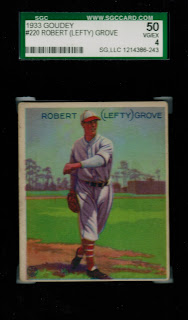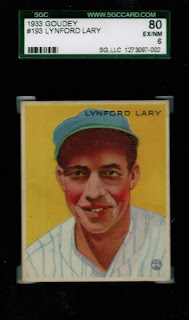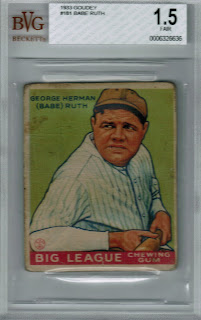 This #133 Fred Lindstrom is one of several recent pickups for my set. As will be shown in future posts, it is an example of the lower grade cards that I have been adding to the set in an attempt to be more budget conscious. This particular card came from an eBay auction, which I won for about $15, which I think is a bargain for a Hall of Famer. It was ungraded and I recently submitted it to SGC, which graded it as a 30 (Good).
This #133 Fred Lindstrom is one of several recent pickups for my set. As will be shown in future posts, it is an example of the lower grade cards that I have been adding to the set in an attempt to be more budget conscious. This particular card came from an eBay auction, which I won for about $15, which I think is a bargain for a Hall of Famer. It was ungraded and I recently submitted it to SGC, which graded it as a 30 (Good).Lindstrom was a third basemen and outfielder who played from 1924-1936, primarily for the New York Giants, but also for the Pittsburgh Pirates, Chicago Cubs, and Brooklyn Dodgers. He made a name for himself in 1924 when, at age 18, he got into 52 games for the Giants and batted .333 in a losing effort to the Washington Senators in the World Series. His two best seasons were 1928 and 1930, when he batted .358/.383/.511 (132 OPS+) and .379/.425/.575 (141 OPS+), respectively. He finished second in the MVP voting in 1928.
Lindstrom is a very dubious Hall of Fame selection, gaining election in 1977 from the Veteran's Committee. He only had three excellent seasons (1928, 1930, and 1933). Of his thirteen seasons in the majors, he only played in 130 games or more in seven of those seasons and he was out of baseball at age 30. Lindstrom appears to be among the small subset of players that were elected based on a career batting average over .300. Lindstrom posted a very solid .311 career batting average, but didn't have plus power or plate discipline, resulting in a pedestrian (by Hall of Fame standards) career 110 OPS+. In all, Lindstrom was a solid player, a consistent hitter, but something short of a Hall of Famer. It's hard to justify Lindstrom's inclusion in the Hall of Fame when far more deserving contemporaries such as Babe Herman (who will be featured in a future post) are not enshrined.




